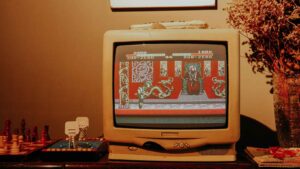As the sun sets on the latest high-tech gaming consoles, there’s a nostalgia-infused dawn breaking on the horizon. Welcome to the world of retro gaming TVs, a realm where pixels are precious and the soundtrack is an 8-bit symphony. This isn’t just about reminiscing the good old days, it’s about appreciating the roots of digital entertainment.
So, whether you’re a seasoned gamer or a curious newcomer, strap in. We’re about to embark on a pixelated journey back in time, exploring the charm, appeal, and enduring legacy of retro gaming TVs.
Understanding the Concept of Retro Gaming TV
Escalating popularity of retro gaming TVs hints at more than just nostalgia. For one, these devices allow gamers to experience popular old-school games in their original format, and that authenticity gets them thumbs up.
Vintage enthusiasts appreciate the unique, vibrant picture quality of the Retro Gaming TV. The inherent capability of these televisions to match the original resolutions of classic games adds a distinct charm. Cathode Ray Tube Technology finds an application, generating high contrast ratios and deep blacks. These qualities are paramount for a rich visual gaming experience.

In terms of performance, these Retro TVs offer lag-free gameplay. On modern screens, retro games often struggle to keep up due to mismatches in refresh rates and pixel density. On the contrary, Retro Gaming TVs are engineered with the classic games’ requirements in mind. They contribute to a nostalgic gaming experience, as set out by classic game designers.
Connection and Compatibility
Retro Gaming TVs surpass the hurdle of connectivity and compatibility found in their modern counterparts. They come equipped with specific ports, including SCART and composite video inputs, allowing hook-ups with a variety of vintage game consoles.
Retro consoles, such as Nintendo Entertainment System and Sega Genesis, can thus be directly connected without any need for adapters. Additionally, many Retro Gaming TVs support RF inputs, a move that caters to older gaming systems like the Atari 2600.
Retro Gaming TV
Finding a suitable TV for retro gaming hinges on identifying core features that influence performance and player experience. Given the rise in popularity for these televisions due to their nostalgic appeal, it becomes integral to evaluate them from a nuanced perspective.
Evaluating TVs for Retro Gaming: What to Look For
When it comes to CRTs or retro gaming TVs, not all models provide the same level of game immersion. Highlights to look for include, bumped-up picture quality, quick response time, and efficient connectivity options for vintage game consoles.

For instance, certain retro gaming TVs boast richer picture quality. Any TV marked for this use should display vibrant colors, deep blacks, acceptable contrast levels and reasonably sharp images. The better these elements, the more immersive the gaming experience becomes.
Response time referring to how quickly a pixel can change color, influences the fluidity of gameplay. Superior retro gaming TVs exhibit quick response times, ensuring lag-free gaming experiences. As gamers, they’d appreciate the absence of delays during fast-paced gaming sessions.
Retro Gaming TVs Available in the Market
Several products dominate the market, each flaunting its unique strengths for retro gaming enthusiasts. These TV models cater to the needs of classic games and their designers, consistently winning the hearts of users. Note, however, that the availability of these TVs can vary, considering they’re not commonly in production anymore.

Hence, certain options to consider include the Sony Trinitron KV series, revered for their stunning picture quality, and flat screen design suitable for 2D games. The JVC D-Series, with high color accuracy and enhanced picture controls, ensure immersive gaming experiences.
Tips for Perfect Gaming Experience on Your Retro TV
Ensure gaming experiences on a retro TV exceed expectations by adjusting gaming modes if they exist, simplifying the image and reducing input lag. Reducing clutter around the gadget fosters a distraction-free gaming environment. Regular cleaning and maintenance, particularly of the CRT screen, significantly enhances the game’s visuals. Additionally, selecting games designed for retro TVs, those with pixel art graphics for example, leverages the CRT’s distinct display capabilities. So, while the setup of retro gaming TVs appears complex, with carefully followed tips, this nostalgic technology grants a remarkable, authentic gaming experience.



